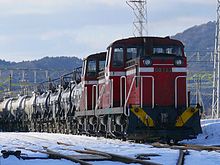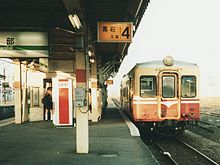Ōu Main Line
| Ōu Main Line | |||
|---|---|---|---|
 Passing the moat of Yamagata Castle Site left: Narrow gauge right:Standard gauge | |||
| Overview | |||
| Native name | 奥羽本線 | ||
| Status | Operating | ||
| Owner | |||
| Termini | |||
| Stations | 102 | ||
| Service | |||
| Type | Main line | ||
| System | JR East | ||
| Technical | |||
| Track length | 486.3 km (302.2 mi) | ||
| Number of tracks | 2 | ||
| Character | Elevated, rural | ||
| Track gauge | 1,067 mm (3 ft 6 in) 1,435 mm (4 ft 8+1⁄2 in) | ||
| Electrification | 20 kV AC, 50 Hz | ||
| |||
The Ōu Main Line (奥羽本線, Ōu-honsen) is a railway line in Japan, operated by the East Japan Railway Company (JR East). It connects Fukushima Station through Akita Station to Aomori Station. Since the opening of the Yamagata Shinkansen on July 1, 1992, the Fukushima–Yamagata section (as well as the Yamagata–Shinjō section since 1999) is sometimes referred to as the Yamagata Line. The name of the line as a whole refers to the ancient provinces of Mutsu (陸奥) and Dewa (出羽), as it connects both ends of Mutsu by passing north–south through Dewa.
Route data
[edit]- East Japan Railway Company
- Total distance: 486.3 km (302.2 mi) (Fukushima–Aomori, Tsuchizaki–Akitakō)
- East Japan Railway Company
- 484.5 km (301.1 mi) (Fukushima–Aomori)
- Japan Freight Railway Company
- 1.8 km (1.1 mi) (Tsuchizaki–Akitakō)
- 256.2 km (159.2 mi) (Yokote–Aomori)
- 4.8 km (3.0 mi) (Aomori–Aomori Stoplight Station)
- East Japan Railway Company
- Rail Gauge:
- 1,067 mm (3 ft 6 in)
- Shinjō–Ōmagari
- Akita–Aomori
- 1,435 mm (4 ft 8+1⁄2 in)
- Fukushima–Yamagata
- Uzen-Chitose–Shinjō
- Both (1,067 mm (3 ft 6 in), 1,435 mm (4 ft 8+1⁄2 in))
- Yamagata–Uzen-Chitose
- Ōmagari–Akita
- 1,067 mm (3 ft 6 in)
- Stations: 102 (including freight stations)
- Tracks:
- Dual-track
- Fukushima–Sekine (1968–91)
- Akayu–Akayu Stoplight Station (1968)
- Uzen-Nakayama–Uzen-Chitose (1968–86)
- Ashisawa–Funagata (1975)
- Nozoki–Innai (1968)
- Ōmagari–Oiwake (1963–94)
- Ugo-Iizuka–Hachirōgata (1969)
- Kado–Moritake (1967)
- Tsurugata–Maeyama (1969–71)
- Takanosu–Hayaguchi (1969)
- Ōdate–Nagamine (1968–71)
- Ishikawa–Kawabe (1967–70)
- Single-track
- Sekine–Akayu
- Akayu Stoplight Station–Uzen-Nakayama
- Uzen-Chitose–Ashisawa
- Funagata–Nozoki
- Innai– Ōmagari
- Oiwake–Ugo-Iizuka
- Hachirōgata–Kado
- Moritake–Tsurugata
- Maeyama–Takanosu
- Hayaguchi–Ōdate
- Nagamine–Ishikawa
- Kawabe–Aomori
- Dual-track
- Electrification: All (alternating current 20,000 V 50 Hz)
- Block system: Automatic block system (except Tsuchizaki–Akitakō section (gearing block system))
- Depots: Yamagata, Akita
Services
[edit]The Ōu Main Line is split into the following four sections. Due to the differences in the tracks of these sections, there are no trains that go through more than one (with the exception of an Akita–Shinjō connection). Local and rapid services on the line are generally operated by 701 series (entire line) and 719 series (Fukushima - Shinjō only) electric multiple unit trains.
Fukushima–Shinjō (148.6 km)
[edit]On this section, the Ōu Main Line shares the tracks with the Yamagata Shinkansen. The rail gauge is 1,435 mm (4 ft 8+1⁄2 in) to allow the Yamagata Shinkansen to run on it. The Ōu Main Line is known as the Yamagata Line on this section.
Shinjō–Ōmagari (98.4 km)
[edit]Crossing the Yamagata-Akita border, there is little demand in this section, and all trains except one limited-stop "Rapid" train run as all-stations "Local" trains.
Ōmagari–Akita (51.7 km)
[edit]On this section, the Ōu Main Line shares the tracks with the Akita Shinkansen. Because the Ōu Main Line occasionally runs from Akita to Shinjō as a local train, this section contains one standard gauge track and two narrow gauge tracks. Also, the few Komachi trains running on this section have the priority.
Akita–Aomori (185.8 km)
[edit]Together with the San'in Main Line, Maizuru Line, Obama Line, Hokuriku Main Line(including the IR Ishikawa Railway, Ainokaze Toyama Railway, and the Nihonkai Hisui Line), part of the Shinetsu Main Line(including the Myoko Haneuma Line), Hakushin Line, and the Uetsu Main Line, this section of the Ōu Main Line is one of the express lines and freight lines that make up the Nihonkai Jūkan-sen (Sea of Japan Trans-Japan Line).
Station list
[edit]History
[edit]The Japanese national government built the Ōu Main Line, starting construction from Aomori in 1894, from Fukushima in 1899 and linking the two sections in 1905. In 1909 the formal name of the line was declared.
Opening dates for the individual sections are as follows.
Ōu North Line
[edit]- December 1, 1894: Aomori–Hirosaki
- October 21, 1895: Hirosaki–Ikarigaseki
- June 21, 1899: Ikarigaseki–Shirasawa
- November 15, 1899: Shirasawa–Ōdate
- October 7, 1900: Ōdate–Takanosu
- November 1, 1901: Takanosu–Noshiro (present-day Higashi–Noshiro)
- August 1, 1902: Noshiro–Gojōme (present-day Hachirōgata)
- October 21, 1902: Gojōme–Akita
- October 1, 1903: Akita–Wada
- August 21, 1904: Wada–Jingūji
- December 21, 1904: Jingūji–Ōmagari
- June 15, 1905: Ōmagari–Yokote
Ōu South Line
[edit]
- May 15, 1899: Fukushima–Yonezawa
- April 11, 1901: Yonezawa–Yamagata
- August 23, 1901: Yamagata–Tateoka (present-day Murayama)
- October 21, 1901: Tateoka–Ōishida
- July 21, 1902: Ōishida–Funagata
- June 11, 1903: Funagata–Shinjō
- October 21, 1904: Shinjō–Innai
- July 5, 1905: Innai–Yuzawa
- September 14, 1905: Yuzawa–Yokote, completion of Fukushima–Aomori connection
Line upgrading
[edit]Various sections of the line have been double-tracked since 1963.
The section between Niwasaka and Akaiwa stations proved to be geologically unstable, with one of the original tunnels collapsing in 1910. A realignment involving two new tunnels was opened a year later. Geological instability was suspected as the cause of a derailment on the section in 1948 that killed three crewmen, and another realignment was undertaken when the section was double-tracked in 1968.[citation needed]
Itaya station was originally a reversing station, and was realigned as a through station in conjunction with the gauge conversion work (see below) in 1990.
Electrification
[edit]The Fukushima to Yonezawa section was electrified at 1,500 V DC in 1949, and the Uzen-Chitose–Yamagata section in conjunction with the Senzan Line (also at 1,500 V DC) in 1960. Trials on the Senzan Line subsequently resulted in the adoption of 20 kV AC for all further electrification, and the abovementioned sections were converted to the new standard when the Yonezawa to Yamagata section was electrified in 1968. The Aomori to Akita section was electrified (at 20 kV AC) in 1971, as was the Akita to Uzen-Chitose section in 1975.[citation needed]
Former connecting lines
[edit]


- Akayu Station: The Yamagata Prefectural Government operated a 2 km 610 mm (2') gauge human powered tramway between 1919 and 1926.
- Oishida Station: The Obabazawa Railway opened a 3 km line to its namesake town in 1916, the line closed in 1970.
- Yuzawa Station: The Ogachi Railway Co. opened a 12 km line to Zentsu, electrified at 600 V DC, between 1928 and 1935. The last 3 km section closed in 1967, the electrification was decommissioned in 1971 and the rest of the line closed in 1973.
- Yokote Station: The Yokote Railway opened a 38 km line to Oikata between 1918 and 1930. Construction commenced on an extension to Maego station on the company's Yuri Kogen Railway Chokai Sanroku Line but was not completed. The 12 km section from Oikata to Niiyama was closed following typhoon damage in 1947, the 7 km section from Niiyama to Tateai closed in 1965 when a bridge was destroyed by floodwaters, and the balance of the line closed in 1971.
- Akita Station: The 762 mm (2'6") gauge Nibetsu Forest Railway, consisting of a 22 km main line and five branches between 1.3 km and 5 km in length (and a 550 m tunnel) operated between 1909 and 1968.
- Hachirogata Station: The Akita Chuo Kotsu operated a 4 km line to Gojome, electrified at 600 V DC, from 1922 until 1969.
- Odate Station: The Kosaka Railway opened a 23 km 762 mm gauge line to its Kosaka Refinery in 1908, together with a 4 km branch from Shigenai to Kizawa the following year. Passenger services ceased on the Kizawa branch in 1926, and it closed in 1951. The 10 km Kosaka to Shigenai section was electrified in 1928, and extended 6 km in 1949, but was decommissioned when the line was converted to 1,067 mm gauge in 1962. Passenger services ended in 1994, and the remaining traffic was sulphuric acid, but following two major derailments the line closed in 2009.
The company also opened a 5 km 762 mm gauge line to the Hanaoka mine in 1914 including a bridge over the Ōu Main Line at Odate, which was converted to 1,067 mm gauge in 1951 to enable ore wagons to be forwarded via JNR trains. Freight services ceased in 1983 and the line closed in 1985.
- Kawabe Station: The 7 km line to Kuroishi was opened in 1912, transferred to the Konan Railway in 1984, the year that freight services ceased, and closed in 1998.
Gauge conversion
[edit]Full standard Shinkansen lines are constructed using 1,435 mm gauge track on a separate alignment, with a high speed (240–320 km/h or 150–200 mph) and a commensurately high construction cost. Following privatisation and regionalisation of the JNR network in 1987, the JR East company decided to convert the Fukushima–Yamagata section of the 1,067 mm gauge Ōu Main line to 1,435 mm gauge, enabling Shinkansen trains from Yamagata to travel on the Tohoku Shinkansen line through to Tokyo. Called Mini-shinkansen, this was a cost-effective way of providing an improved level of service on the line, although only purpose-built Shinkansen trains can travel on such lines, as the loading gauge was not changed, nor the voltage (full standard Shinkansen lines use 25 kV AC). The Yamagata Shinkansen opened in 1992, and although the maximum speed is 130 km/h (81 mph), the overall transit time to places beyond Fukushima is improved due to the elimination of the need to change trains at the junction.
The success of this project led to the conversion of the Omagari to Akita section in conjunction with the opening of the Akita Shinkansen in 1997, and the extension of the Yamagata Shinkansen to Shinjo in 1999. These projects also created parallel 1,435 and 1,067 mm gauge lines between Omagari and Akita and between Yamagata and Uzen-Chitose respectively, and a dual-gauge section between Jinguji and Minejoshikawa (on the Omagari to Akita section), enabling Shinkansen trains to pass at speed on the mostly single-track line.
Additionally, local services continue to be provided on the gauge-converted lines by 701-5000 series standard-gauge suburban/interurban rolling stock.
Notes
[edit]- ^ Rapid Resort Shirakami doesn't stop at the station
References
[edit]External links
[edit]- Stations of Ōu Main Line Line (JR East) (in Japanese)

